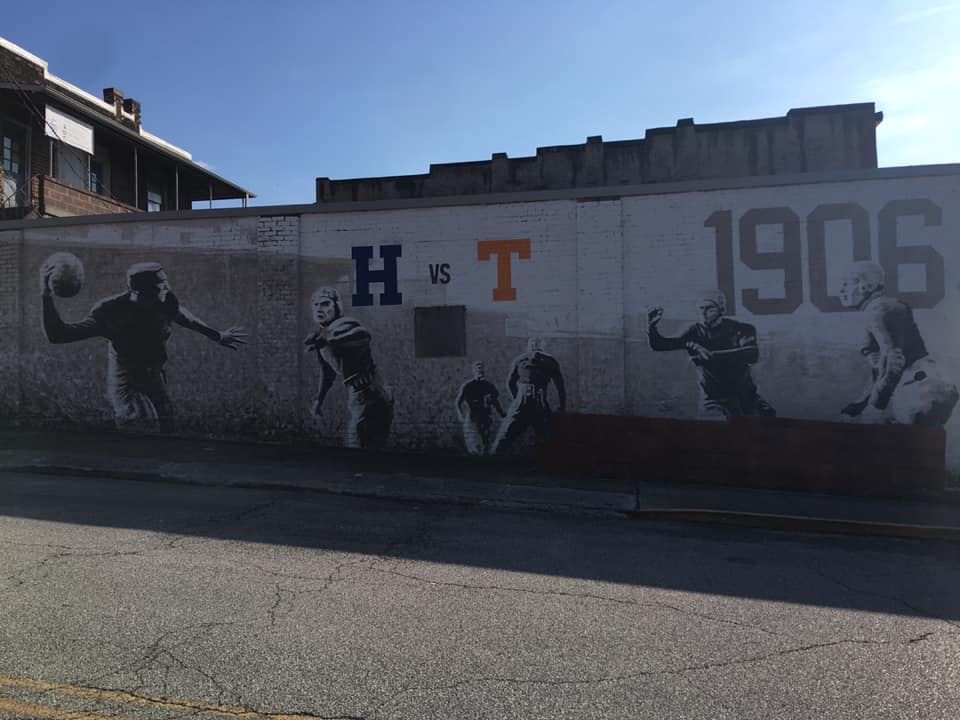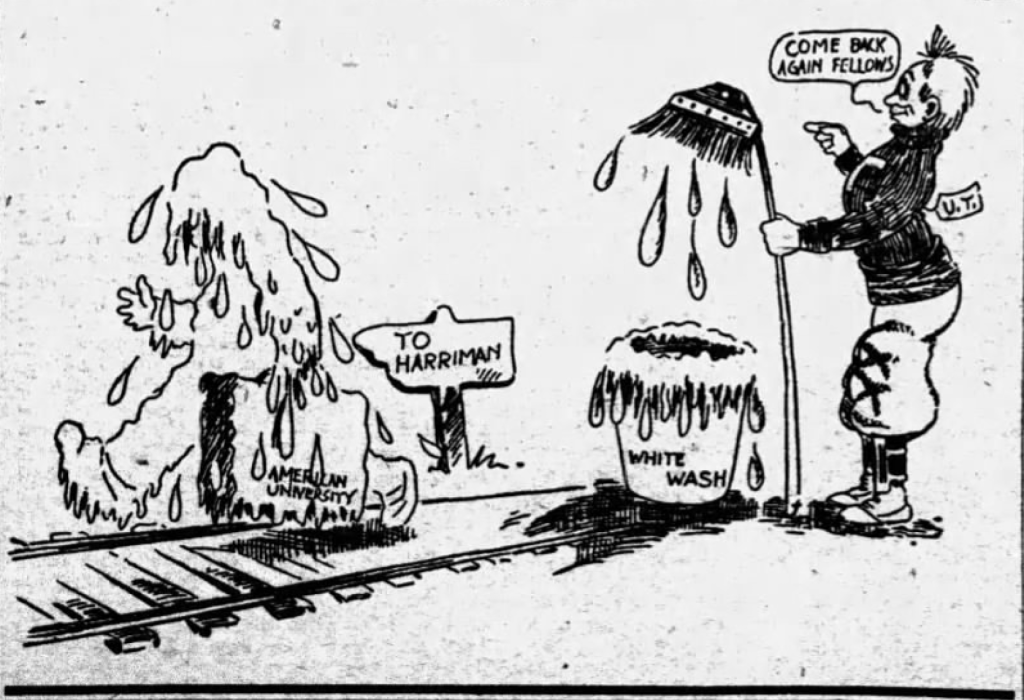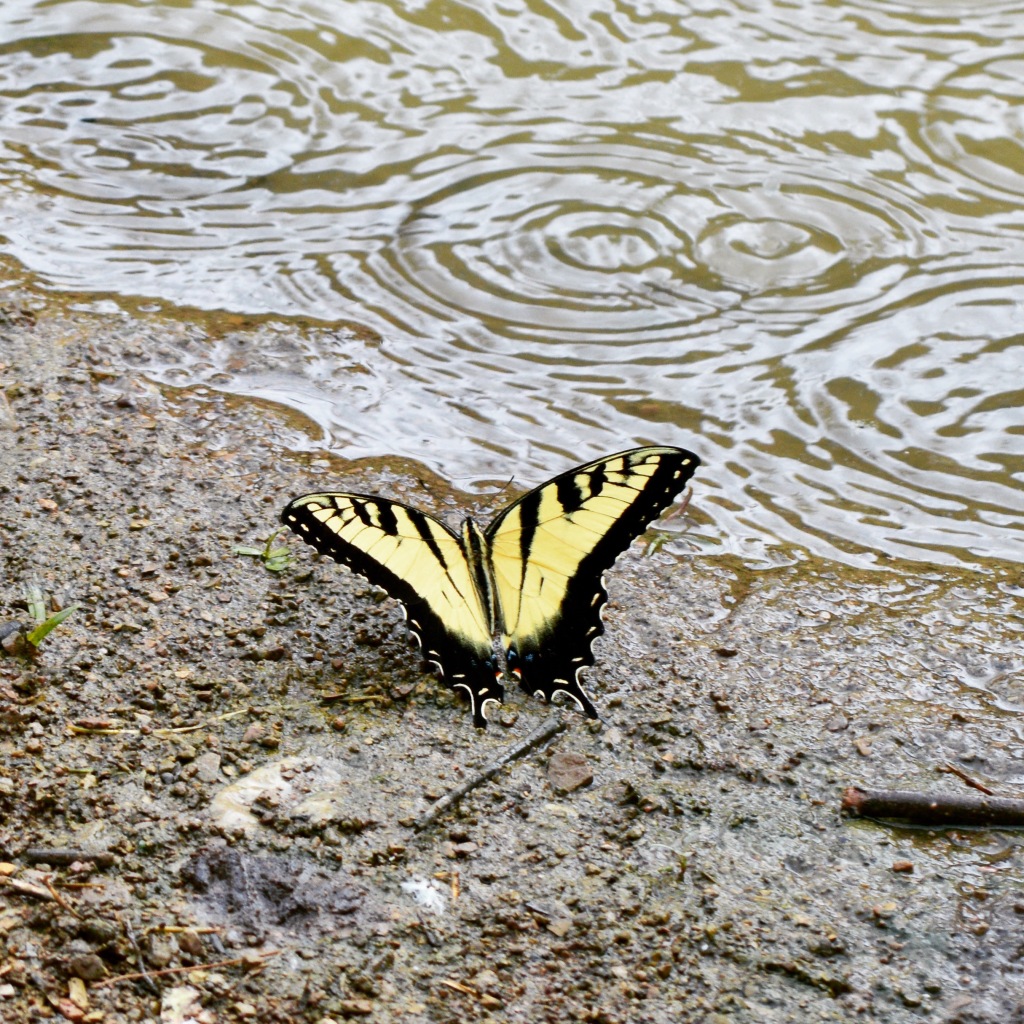
Update: this article was updated on September 2, 2021 to add the account of Bill Donaldson.
As we enter another college football season, I have been thinking about football seasons of long ago, when a team of students from a small university in Harriman took on the mighty Volunteers of the University of Tennessee. American University had been established in Harriman in 1893 as the American Temperance University, reflecting the city’s founding ideals as a utopia of temperance. One of the university’s goals was to “teach the young the various branches of learning and to inculcate temperance and total abstinence principles and the principles of political economy in regard to the use of intoxicating liquors.” Though the university’s name would change to simply the American University of Harriman in 1900, these ideals would remain. Under the leadership of Chancellor James Tate, who also served as football coach, the university was well known for its temperance ideology and strict codes of discipline for students.[1]
Though the university presumably did not have much of a party scene, it did have a football team. It must have taken hubris to believe that a team representing the American University of Harriman could defeat the Vols, and indeed, the Knoxville Sentinel the day before described the 1905 game as a practice game and reported that “the Volunteer lads do not consider the members of the American university team their equals.”[2] Even the Chancellor Tate, coach of the American team, reportedly did not expect his team to prevail.[3] If you’re expecting the team from Harriman to silence the critics, you will be disappointed: Tennessee was victorious by a score of 104-0, the most lopsided game in UT’s history. But the story does not end there, and the brief “rivalry” between American and UT would continue for one more year.
The 1906 football season kicked off for Tennessee with a home game against American. American had already played Maryville and lost, 22-0. UT, coached by James Dupree, must have been confident going into the game, but Vol fans expecting a blowout would be disappointed. UT was victorious only by a 10-0 score. One newspaper account credited American with playing a strong defensive game, and having “two or three spanking good players,” while also noting that the team had practiced more than UT’s, though UT’s Coach Dupree was said to have been happy with his team’s performance.[4] A rule change for the 1906 season, which stipulated that a team must gain ten yards in three plays (previously, it had been only five yards in three plays), as well as a wet field, might have also been partially responsible for the low scoring affair.[5]

If American was angry about the loss, they would not have to wait long for a chance at revenge. Less than three weeks later, on October 19, 1906, the Vols traveled to Harriman to face American on their own field. This game holds the distinction of being the only football game the Vols have ever played in Harriman and makes Harriman one of only eight cities in Tennessee to have ever hosted a UT football game.[6] The game appeared to be on its away to a close affair: both teams scored early touchdowns but missed their extra points, and in the first half the score stood at 5-5 (touchdowns were worth 5 points in those days).
Animosity between the two teams seems to have been evident from early in the game, perhaps a result of the previous year’s blowout. “The game was noted for its squabbles,” reported the Knoxville Sentinel, though the squabbles were not serious at first. This changed when an American player named Davis supposedly tackled a UT player named Ring out of bounds and punched him. The umpire, named Word, pulled Davis up, but spectators began assaulting Ring, leading to an all-out brawl on the field. The brawl apparently involved both players and fans. Davis was ejected from the game, but refused to leave the field, and the American team stood by him. As a result, the officials declared that American had forfeited and ended the game, though UT’s official records would record it as a 5-5 tie.[7] The fight did not end on the football field. When UT’s team arrived at their hotel in Harriman, Umpire Word was arrested on an assault charge. A witness claimed that Word had struck Davis while pulling him off of Ring. The case was quickly dismissed when Davis stated on the witness stand that he did not recall Word striking him.[8]
According to another account, the first forward pass in UT history was completed during the game in Harriman. Bill Donaldson, an end for the 1906 team, recalled over 60 years later that he had received the pass. This angered American fans, who had never seen a pass and thought it was a dirty play. Anger among American fans led to a major confrontation which ended with the UT football team being arrested. They were released only after they promised “not to say anything to the Knoxville newspapers about the incident.”[9]
Ill feelings resulting from the brawl between the two teams would lead to UT never playing American again.[10] Apparently, American’s team was developing a bad reputation. In 1907 they played a high school team from Chattanooga to a 0-0 tie. The high school players would complain of being treated poorly in Harriman, particularly by unfair officials who they felt had robbed them of a win.[11] Soon thereafter, American canceled a game against Chattanooga University (now UT-Chattanooga), supposedly blaming the high cost of improvements, particularly the cost of steam heat. “Steam heat comes high in Harriman, you know, and my improvements have cost over $1,500,” Chancellor Tate claimed, stating he needed to cancel the game in response.
Chattanooga scheduled UT in American’s place and had a rather brutal response:
“I was glad that the Harriman date was broken, especially after I got the Tennessee game. None of the men have cared about going to Harriman, and especially after the high school eleven was treated so badly there last Monday. The Tennessee game will give us some prestige, while we would gain nothing by playing with Harriman. We are going to get to play a real football team Saturday. The game was called off partially because Chancellor Tate recently had steam heat put in his house, and partially because he lost $35, so he claims, on the high school game.”[12]
By that time, American University was facing serious problems and did not have much time left. A year later, the university folded following the 1908 commencement ceremony, ending its 15 years of service.[13]
American University’s buildings were then taken over by the Mooney School, a prep school founded by W.D. Mooney. Surprisingly today for a high school but fairly common in the early twentieth century, the Mooney School played two football games against UT in Knoxville, causing the Vols “a severe fright” before losing 7-0 in 1910[14] and 27-0 in 1911. In a report prior to the 1911 game, the Journal and Tribune reported that Mooney might pose a challenge for the Tennessee, as the team “may be just has heavy as the Volunteers, and in fact may have a few pounds of brawn to spare. Rumor has it that two giants, weighing respectively 200 and 190 pounds, and brothers” played for Mooney.[15] A few weeks later, Mooney would also play a game against the UT “scrubs” while Tennessee’s varsity team traveled to Raleigh to play North Carolina State.[16] The outcome of the “scrubs game” is not known.
Though those would be the only football games Mooney played against the Vols, the school in Harriman would play them at least twice in basketball, hosting a game in February 1911. Mooney’s boys basketball team entered that game with a record of 8-1 and dominated the basketball Vols, taking a 21-4 halftime lead en route to a 43-13 Mooney victory over the visiting team.[17] The Mooney School would close not long after, folding due to lack of capital financing in 1912.[18]
Following the folding of American University, and the end of the African-American East Tennessee Normal and Industrial Institute around 1912,[19] Harriman would not have another institution of higher education until Roane State Community College was established in 1971. The RSCC Raiders have never sponsored a football team, so they could not avenge the 104-0 loss of American back in 1905, or the brawl in Harriman in 1906. If the orange flags and stickers seen in Harriman these days are any indication, though, the animosity toward UT from the 1905 and 1906 seasons seems to have dissipated.
[1] Walter Pulliam, Harriman: The Town that Temperance Built (Maryville, TN: Brazos Press, 1978), 257-275.
[2] “Harriman Team Here Saturday,” Knoxville Sentinel, October 5, 1905.
[3] “Tennessee’s Fast Team Piles Up an Immense Score,” The Journal and Tribune, October 8, 1905.
[4] “Tennessee University 10, American University 0,” The Journal and Tribune, October 7, 1906.
[5] “Tennessee Wins Its First Game,” Knoxville Sentinel, October 8, 1906.
[6] Tom Mattingly, “How Many Cities?” September 9, 2016, http://knoxblogs.com/volhistorian/2016/09/09/how-many-cities-2/.
[7] “1906 Football Schedule,” https://utsports.com/sports/football/schedule/1906.
[8] “Football Games Ends in a Row,” Knoxville Sentinel, October 26, 1906.
[9] Betsey B. Creekmore, “First Football Forward Pass,” Volopedia, University of Tennessee Libraries, September 25, 2018, https://volopedia.lib.utk.edu/entries/first-football-forward-pass/.
[10] Pulliam, 1978
[11] “Harriman Talks Some,” Chattanooga Daily Times, November 3, 1907.
[12] “Steam Comes High,” Chattanooga Daily Times, October 31, 1907.
[13] Pulliam, 1978.
[14] “Severe Fright for ‘Varsity,” The Journal and Tribune, October 9, 1910.
[15] “Aspirants for Football Jobs,” The Journal and Tribune,October 6, 1911.
[16] “Volunteers Go to Raleigh,” The Journal and Tribune, October 27, 1911.
[17] “Tennessee Team Loses to Mooney’s Fast Five,” Knoxville Sentinel, February 27, 1911.
[18] Pulliam, 1978.
[19] Pulliam, 1978.
